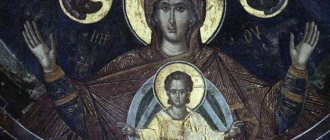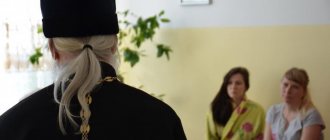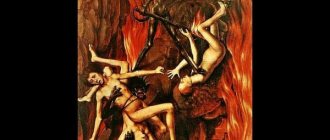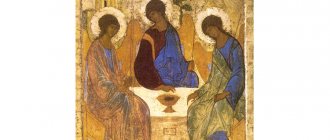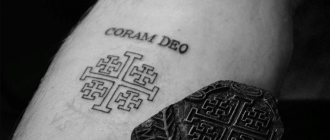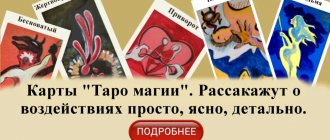Once I witnessed the tearful request of a young priest addressed to Father Jonah (Ignatenko): “Pray, father, for my mother - my mother is not serious.” It was not in vain that the young priest cried, because the unhappy marriages of priests hit the parish painfully. Those who are weak in faith fall away from the church, and for everyone without exception, divorce or a quarrel between a priest and his wife becomes a temptation. The happiness of the priest and the well-being of the parish depend entirely on the mother.
The life of a priest's wife can be briefly described : endless work, patience, prayer. This is not boasting - the Lord sets such conditions that mother can only comply with them.
About hardship and humility
Mother’s life is inextricably linked with her husband’s ministry. Especially in small towns and villages, where everyone knows the priest’s wife. As one archpriest aptly put it, life in a parish is like life in an aquarium - in full view of everyone . On the one hand, this is quite unpleasant. On the other hand, he disciplines his mother. For example, if a priest’s wife goes out into the city in trousers, she’ll definitely meet someone she knows—it’s inconvenient. You have to wear a skirt. I have to stop yelling at my husband. Or scream quietly so that no one knows. And “saw” it quietly. And quietly want attention and affection. And you want a new dress quietly. Or completely silent.
Mother's life is hardship . The priest alone cannot feed a family, and often a large one. All family members have to put up with it - the children wear someone else’s clothes, the mother and father wear whatever they need. And when the question arises of what to buy - a new cassock for the priest or a dress for the mother, the choice falls on the cassock. After all, the priest needs to travel to meetings, bishop services, and on business. If a mother works, she has to combine work with raising children, serving in church, and household chores. In a rural parish, a vegetable garden and livestock are added to everything.
“Mothers” or Who are they – the wives of priests?
Estimated reading time: 3 minutes.
Photo www.pravmir.ru
Is it easy to be a priest's wife? Should young girls strive for this? This and other problems in the lives of priests’ families were discussed at the presentation of journalist Ksenia Luchenko’s book “Mothers,” which took place yesterday at the cultural center.
Actually, Ksenia’s work itself consisted of finding, persuading for a conversation, recording, and then recounting the story of this or that priest’s wife. As it turned out, this was sometimes not so easy to do.
According to the author, the book took a long time to create; not all families of priests’ wives agreed to personal conversations. Some of the mothers spend a lot of time taking care of the house, household, children, while others simply did not want to show off their family life.
— Actually, the idea of creating a book took quite a long time to formulate. It all started a few years ago, when an Orthodox television studio came up with the idea of creating a program like “While Everyone is Home,” only it was supposed to tell about Orthodox families. However, this idea happily died, since it turned out to be almost impossible to persuade the families of priests to do this. They refused because they were busy and had numerous worries about the household and children. They also refused because they simply did not want to reveal their family life for everyone to see. It is clear that the idea was somewhat premature.
However, the book “Mothers” was published.
— These living stories have become important today, when there is increased interest in the Church. People were really waiting for something like this – a calm story about the essence of church life,” Ksenia Luchenko summed up her story. Many from the audience, including those who are not so close to the Church, agreed with these words.
Unfortunately, of the book’s heroines, only Mother Olga, the wife of priest Andrei Yurevich, was able to come to the presentation.
— When I opened the book, I read my story first, because I was scared by what I said there. It's one thing to say to a friend, and another thing to say it in print. And then I thought that if it had been somehow specially edited, smoothed out, then much of what was very dear to me would have been lost in it. It's probably good that it turned out that way.
Mother Olga also noted the style in which the book was written. In her opinion, it was very interesting to read it, since each story was presented in its own way.
“I was very surprised and very happy that the story of each mother was told completely differently. There were no identical questions, and the presentation form itself was always completely different. I think that, indeed, different destinies required different presentation.
Father Valery Stepanov noted the importance of those global themes that are revealed in the stories of the mothers:
— These topics are relevant not only in the internal space of the Church, but also for those people who generally try to think about the world around them, about themselves in this world. It is very important that these issues are discussed not only in the church environment, but also outside it,” the priest noted.
At the end of his short speech, Father Valery made an interesting proposal:
“I think that Ksenia now faces a different task. I would like Ksenia to try herself in fiction. It seems to me that the galaxy of our modern women writers who touch upon important ideological issues in their books can and should be continued.
Preacher, organizer, psychologist
Like any Christian, the wife of a priest brings the light of Christ to the world. She unwittingly becomes a missionary, a person preaching the Gospel. And this sermon can be completely silent. Mother’s behavior, her speech, and actions are under close supervision of both Christians and atheists. In addition, there are always people who want to learn about Christ, the Church of Christ. Mother must be educated and be able to answer questions competently and comprehensively. There is an expression that mother is a priest in a skirt . Indeed, women, especially women of the same age, often turn to the priest’s wife for advice.
Matushka, without exaggeration, is the center of parish life. She has to organize children's matinees, social work, meals and cleaning in the temple. Mother Regent conducts choir rehearsals, learns new chants, and leads the choristers during the service.
Often the mother plays the role of her husband’s personal psychologist. Father has moments and even periods of despondency, relaxation and loss of strength. Mother consoles, encourages, listens and motivates to move on.
Olesya Nikolaeva
Archpriest Vladimir Vigilyansky (b 1951) – head of the press service of the Patriarch of Moscow and All Russia, cleric of the home church of the martyr Tatiana of Moscow State University. M. V. Lomonosova, publicist and literary critic. Graduated from the Literary Institute named after. A. M. Gorky. Member of the Union of Journalists of Russia and the Union of Russian Writers.
Olesya (Olga) Nikolaeva (b 1955) is a poet, prose writer, essayist, author of several books of poetry and novels, winner of many awards, including the Russian National Poet Prize. Teaches literary skills at the Literary Institute named after. A. M. Gorky. Member of the Writers' Union; member of the Russian Pen Center. She raised three children.
I was born into a Moscow writer's family. My father, Alexander Nikolaev, wrote poetry, was deputy editor-in-chief of the Friendship of Peoples magazine, and my mother was a journalist and translator. My childhood coincided with Khrushchev’s “thaw” - a time that seemed very rosy to the intelligentsia. So the atmosphere of our house was always festive: the house was full of friends and guests, among whom were famous poets, directors, and actors. By the way, I still have this feeling of the festivity of life - life as a holiday, although the very concept of a holiday has changed.
Of the people with whom my parents were friends, it seems that none of them went to church at that time. The only church person who was nearby was my grandmother Nadya. But she lived with other granddaughters, whom she baptized in infancy, and somehow she didn’t enlighten me very much about the church. Maybe she thought my parents should be doing this. True, from time to time she told me amazing stories about saints and holy fools, about the prophecy of the holy fool Pasha of Sarov to the Emperor about the birth of a son who “will be an heir, but not a king.” All this, as I heard from my grandmother, the holy fool Pasha visually depicted while playing with rag dolls, which really amazed me.
Spiritual life
The most important thing in mother’s life is prayer. At first, the Lord teaches prayer while waiting for children. A difficult pregnancy or infertility gives rise to fervent prayer. Then the prayer begins for a successful birth and for the health of the baby. About family well-being, about the priest and the parish. About parents and relatives. About friends and acquaintances. About those who offend and hate. About the salvation of the soul and the bestowal of grace.
Without prayer, the priest's family is doomed to death. And while the priest works for the Church, the mother takes care of the family hearth.
It's not easy being a mother. But when it’s really difficult, the Lord comes to the rescue. Himself personally. He feels sorry for his many-caring Marthas. He says “Marfo, Marfo, worry and speak about many people...” and wipes tears from his eyes.
Father Artemy Vladimirov: there are no trifles in marriage
Domes in the sky of Tagil
Resurrection parish became the first Orthodox community in Vagonka (Nizhny Tagil region - editor's note). The first church - the Intercession of the Blessed Virgin Mary - was built so that believers would not have to walk 20 kilometers to the only church operating at that time in the city. Very quickly this small church began to fill up, so in the mid-90s construction began on a large church in honor of the Resurrection of Christ. Now it hosts Sunday and holiday services. Vlada’s husband, 31-year-old Father Andrei, serves in both churches.
The parish has a stylish website and a public page on VK. Its history and parish social projects are described in detail there.
|
| This is what the Church of the Intercession of the Blessed Virgin Mary looks like. When she saw the domes, she said that they emphasized the cloudy sky. “From the cradle to the grave we are gloomy, like the sky above Tagil,” Father Andrei quoted the song “Caste” in response to me. |
The photographer and I arrived in Tagil at 10 am on Sunday. While the priest is serving the liturgy, we meet with mother near the temple. Here Vlada spends weekends and almost all her free time, and in general she works at the Nizhny Tagil Museum of Fine Arts. Father Andrey has three higher educations: philosophical, theological and pedagogical.
|
| Vlada and Andrey met through Andrey’s younger sister. |
— Most of his knowledge also comes from his father, who is also a priest and very cool. For now, I’m the hashtag “bad mother.”
Vlad immediately takes him to see what Resurrection Parish consists of. Here is the first building of the community, a small church, which is now being renovated. It was built for grandmothers who find it difficult to travel 20 kilometers from Vagonka to the temple in the historical part of Tagil. In this building, the liturgy begins at 7 a.m. and ends at 9 a.m. for those who work on Sunday.
Further on the way stands a building painted with graffiti with biblical motifs. This is a Sunday school attended by 100 children from 5 to 16 years old. There are few Sunday schools with more than 30 children, Vlada says with joy.
“Our teenagers hang out here all the time.” Contrary to stereotypes, they are modern, smart and beautiful, and not those who have not entered into society.
Vlada and Andrey strive for education to become an important part of the life of the parish. There are departments inside the church: for example, the department of catechesis and everything related to science and education, the youth department, social department, work with prisons and others.
|
— In small towns, the rector of the temple often heads some department. Father Andrey is the head of the department of education and catechesis. We want to build a large lecture hall so that people will come to the talks. We already have at least two conversations before the baptism of children, for example, so that parishioners understand why they should be baptized, so that they study religion.
The church also has a Sunday school for adults, occasional lectures on the meaning of worship and the teaching of the Holy Fathers, and other projects. The library contains books about Orthodoxy, Christianity, and history.
“We are advanced Orthodox Christians here,” says Vlada. — We want people to read more.
Recently, by the way, a book club opened at the temple.
Christians should live without scandals
The service ended, Father Andrei was freed. We head to the refectory to talk with him. I’ll immediately start talking about the two latest conflicts involving Orthodox Christians.
|
“Maybe I’ll say some sedition and the people of Yekaterinburg won’t like it, but St. Catherine’s Cathedral is not only their temple,” answers Father Andrei. “This is a temple that should unite believers throughout the region. The burden of a capital city is to take care not only of itself, but also of those who live around it.
He says that he did not have time to understand how the unrest occurred.
To the point
No room for error
Priests take the choice of a future wife very seriously, since they have the right to marry only once in their life. Archpriest Vadim Shapran noted that in the event of the death of mother in ancient times, the priest was obliged to go into monasticism, but later the clergy allowed the priests to remain in the white clergy without the possibility of remarriage.
If, by a fateful coincidence, a widowed clergyman finds the lady of his heart for the second time, then he is necessarily faced with a choice: rank or personal happiness. Having chosen a new life partner, he, of course, is deprived of his rank and becomes a laity.
Unlike parishioners, priests can divorce a quarrelsome wife only if she has been convicted of adultery. At the same time, the priest will not have a second attempt to create a happy family. That is why priests, having learned about their wife’s betrayal, do not dissolve the marriage, but continue to live with her as with a sister, help each other with housework, but do not have intimate relationships.
Mother's life
Modern mothers can drive a car, wear fashionable clothes, work in secular organizations and even use decorative cosmetics.
However, the overwhelming majority of priests' wives devote themselves entirely to their large family and husband, helping him in the parish. They must cover their heads, wear long dresses, do not dye their hair, do not do their hair or haircuts, and do not correct their appearance with makeup.
The mothers are calm about the fact that their husbands have long working hours, and about the fact that they themselves, along with their children, are constantly in the center of attention of the flock.
The wives of priests are prohibited from using contraceptives and having an abortion, and they are required to observe all fasts and church holidays, during which, which is approximately six months, they should abstain from marital intimacy.
Matushka, according to Priest Daniil Sysoev, is the priest’s right hand, who, in addition to fulfilling family responsibilities, helps him run the Sunday school and church choir, serves as his secretary, mediator and even foreman.
Meeting point
Future priests can find their soul mate anywhere, but the main place for them to gather brides is the seminaries, which, in addition to the men's department, have icon painting and regency schools for women. The latter are created, among other things, so that, without interrupting their studies, young people can take a closer look at young ladies brought up according to all the canons of Orthodoxy who want to create a strong family with a clergyman.
Previously, the main school of priests were diocesan women's schools, popularly called diocesan schools, where the daughters of priests and deacons were mainly educated.
Girls in these institutions were voluntarily trained for the difficult role of a priest's wife with all the ensuing consequences.
Nowadays, girls dreaming of tying the knot with seminarians are frequent guests of the villages around the Sergiev Posad Lavra, where local old ladies help modest young ladies meet shy young ministers.

